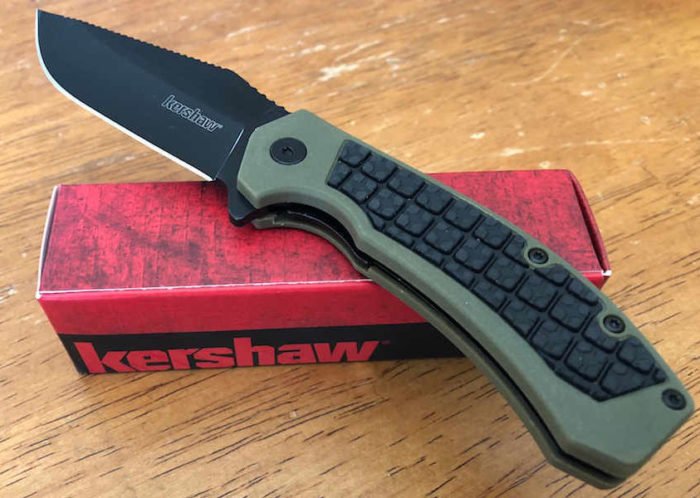Kershaw Knives has recently released its new Faultline everyday carry (EDC) pocket knife. The new Faultline is a compact folding knife with an easy flipper opening, push-bar liner lock mechanism, and lightweight frame. One of the impressive features of the Faultline is the rubberized grip panels giving the user incredibly good grip traction while keeping the overall feel soft and comfortable.
Kershaw Knives made a bold push into the knife market this year, releasing numerous new models in an obvious effort to regain market share and highlight the quality knives made by one of America’s longtime knife makers. In the next few weeks, BlueSheepdog will be conducting reviews on several of these new and impressive knives to give you firsthand feedback on fit, function, and quality of these 2018 Kershaw knives.

Kershaw Faultline
The Kershaw Faultline is a compact EDC folding knife designed to meet every day cutting needs of a good pocket knife. While the Faultline is fairly compact, it is perfectly sized to tuck discreetly into a pocket, on or inside a go-bag, or in your survival kit. The Faultline fits my medium-sized hands very nicely.
The lightweight design, but sturdy clip-point blade really make a nice package for an EDC. The KTV ball-bearing action provides extremely smooth operation, with opening assisted using a perfectly sized flipper.
Specifications
- Knife Type: EDC folding pocket knife
- Action: Blade flipper, KVT ball-bearing opening system
- Safety: Insert liner lock
- Open Length: 7.o inches
- Closed Length: 4.0 inches
- Blade Length: 3.0 inches
- Weight: 3.9 ounces
- Blade Material: 8Cr13MoV (chrome-moly) stainless steel
- Blade Coating: Black oxide
- Blade Type: Clip-point, razor edge
- Handle Material: Glass-filled nylon, rubberized molded panel inserts
- Carry Method: Single position pocket clip
- MSRP: $46.19
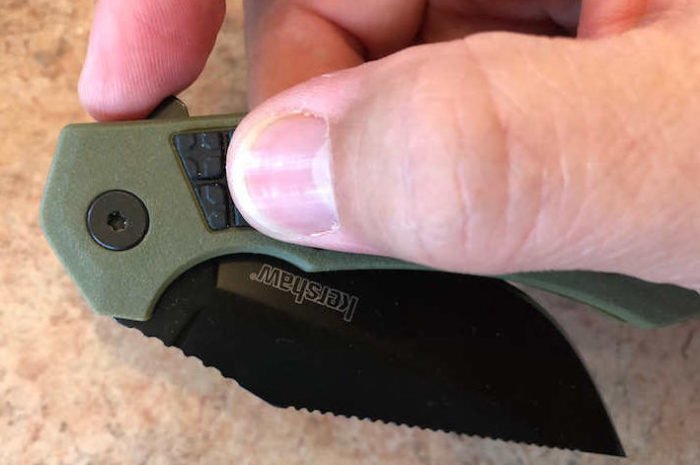
Action
This new folding knife from Kershaw offers a traditional flipper opening design matched with Kershaw’s KVT ball-bearing opening system. The flipper is just the right size to afford a positive grip to the user’s finger while being small enough to avoid snagging.
The KVT ball-bearing design ensures the user very smooth one-handed blade opening, with near glass-like smooth performance. In my handling of the Faultline, I was able to open the blade with minimal effort, while my hand remained close to several master gripping positions.
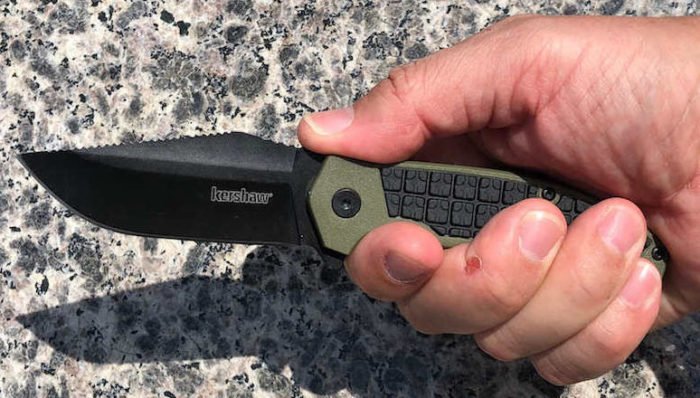
Blade
Kershaw’s Faultline offers an 8Cr13MoV (chrome-moly) stainless steel clip point blade that is nearly as long as the handle. This Kershaw design allows the Faultline to be very compact but still offers a respectable blade length for bigger jobs. Kershaw gives the Faultline a nice black-oxide coating for a tactical or subdued appearance and extra corrosion resistance.
The tip of the blade is a sharp point for puncturing, while the razor-edge provides cutting along the entire front and bottom length of the blade. Kershaw provides a rugged grip texture at the rear of the blade spine perfect for using thumb pressure on tougher cutting jobs. In addition, the Faultline blade as a finer grip texture on the front of the spine for aesthetics and secure cutting pressure at the curvature of the blade. In fact, the Faultline blade is thickest near the tip, to ensure outstanding cutting power at the curvature.
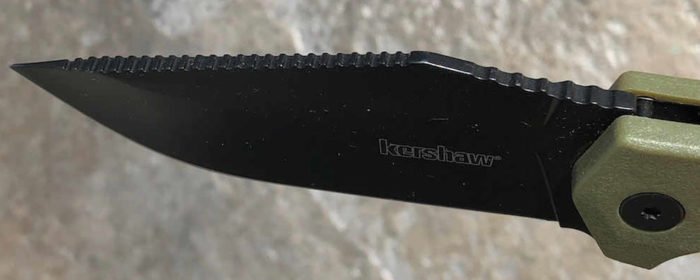
The 8Cr13MoV chrome-moly stainless steel used for the Faultline blade is the Chinese equivalent of Japanese AUS-8 steel or American 440B steel. This stainless steel is considered upper mid-range steel now but used to be a top of the line selection before more modern “super” steels. Using 8Cr13MoV is very common for EDC knife making among many of the reputable knife makers, and when properly heat-treated this stainless steel can provide a great value to cost ratio for the manufacturer and user.
This chrome-moly stainless steel does OK with corrosion and stain resistance. The Rockwell Hardness of 8Cr13MoV is a respectable 58 (compared to super steel CPM M4 with a 63 score), but as expected the softer steel has a lower wear resistance of about 3 out of 10. However, this softer steel allows for easier sharpening when necessary.
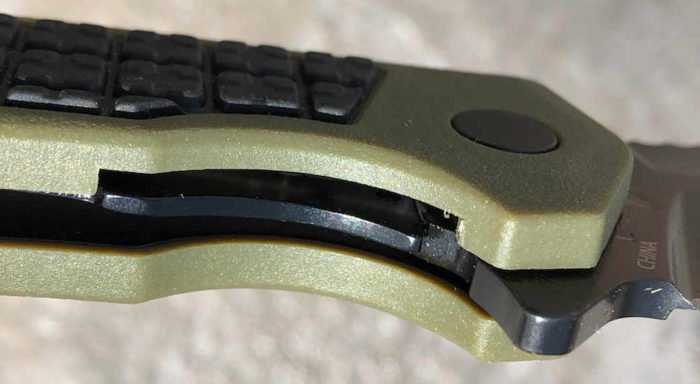
Safety
Kershaw uses a standard sliding locking bar safety for the Faultline. This type of tension bar slides in behind the blade when fully opened to prevent the blade from closing on the user’s hand or fingers during operation. To release the safety, a user simply uses there thumb or fingers to slide the locking bar out of the way while beginning to fold the knife blade closed.
The Faultline locking bar safety is only exposed by about one-inch, keeping the integrity of the grip secure and much nicer for full hand gripping. Despite its short length, the locking bar is easily manipulated by the user’s thumb.
The Faultline locking bar safety is an integrated part of the steel liner for that side of the handle. Half of the steel liner is designed to provide the mounting platform for the glass-filled nylon grip, while the steel is machined about 1/3 of the way up from the pommel to begin the locking bar safety. This provides the strongest possible platform for the locking bar and ensures the longevity of use.

Handle
The Kershaw Faultline is built with a glass-filled nylon handle with an attractive olive color. The glass-filled nylon delivers an incredibly lightweight overall package for the Faultline. Though perhaps more “tactical” in appearance, the Faultline’s colors are perfect for hunting, camping, or everyday carry with a more subdued appearance. The handle is lightweight but extremely durable, and is purpose-built to be resistant to corrosion from the elements or chemical exposure.
Each Faultline comes with dual rubberized grip panels inside of the handle. These grip panels have square-shaped patterns that actually look like common paving stones. However, the panels are much softer than paving stones and provide an excellent gripping surface in contrast to the slicker glass-filled nylon handle. The grooves in the grip panels also provide a perfect channel system to allow water, blood, or other liquids to flow away from the user’s hands during more strenuous knife work.
The Faultline handle is secured with common hex-screw bolts, allowing the user the option to dismantle the knife for any maintenance or cleaning concerns. There is one large hex-screw bolt at the front of the grip housing the KVT ball-bearing mechanism for the chrome-moly blade. The backside of that connection is flush. The rear of the handle is secured with (6) smaller hex-screw bolts, each securely mounted into a steel spacer inside of the grip.
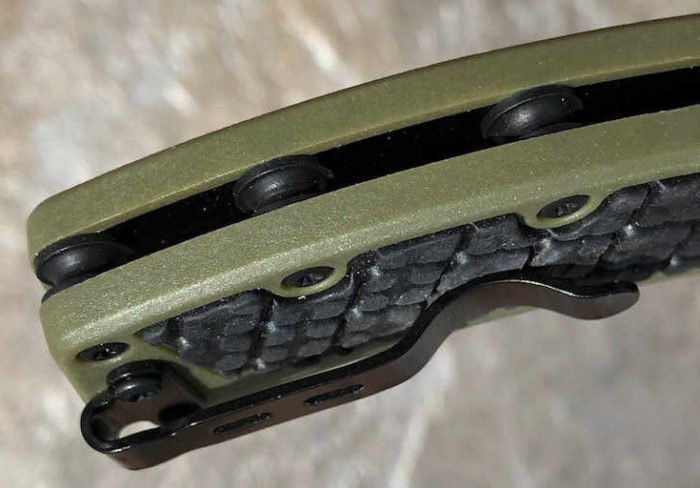
Pocket Clip
Finally, the Kershaw Faultline comes with a single-position pocket clip for blade-up folded carry. Only having one position for the pocket clip will no doubt be a point of contention for some users, but for a right-handed user like myself, it was perfect. The clip itself is fairly short in length but is more than enough to hold the knife in place in my pocket. In addition, the Kershaw pocket clip is mounted high on the frame allowing the knife to sit very deep into the pocket for a very discreet and almost completely concealed carry.
It is somewhat surprising for Kershaw to only offer one mounting option for the Faultline, but I do appreciate the smaller clip that stays nicely out of my hand’s grip during use. Should a user prefer a different mounting location (e.g. left-handed), there is enough space in the glass-filled nylon handle for the user to drill new holes and mount the clip on the opposite side. For that matter, there is enough space to mount the clip at the front of the handle for tip-down carry, though I am personally not a fan of modifying knives to that extent.
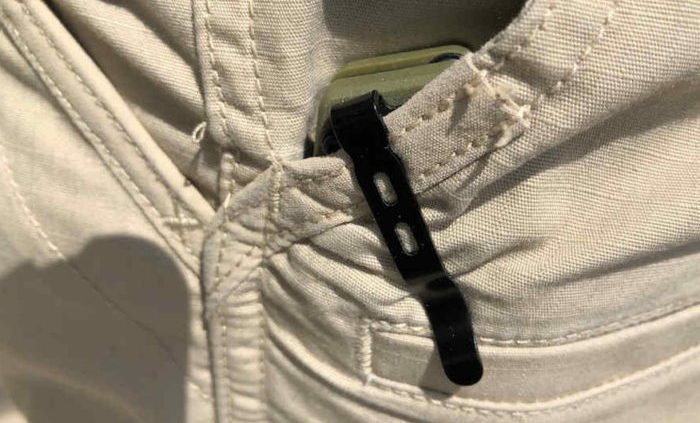
One distraction we found during testing the Faultline involved the combination of the rubberized grip inserts and the pocket clip. Inserting the Faultline into a pocket for carrying was no problem, but trying to retrieve the knife became problematic. The rubberized grip inserts provide a tacky enough texture to grab the pocket material. In addition, the pocket clip is pretty stout as delivered so the added pressure on the pocket really enhances the rubberized grip’s ability to hold onto pocket material.
A solution is to work at opening the pocket clip until it is a little looser. The clip’s end is curved upward so a user can pry the clip away from the pocket to allow an easier withdrawal, but only realistically after the clip has been worked with so it’s not so stiff.
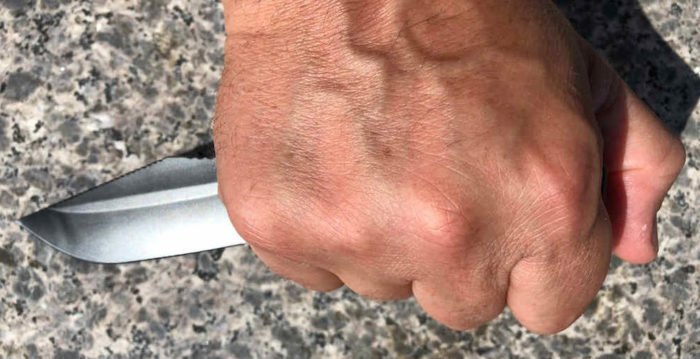
Final Thoughts
My first impressions of the Kershaw Faultline were very positive. The olive and black colors compliment each other and produce an overall attractive knife. I enjoyed the compact design for an EDC knife option. The KVT ball-bearing opening assistance was perfectly matched with an angled flipper that was just the right size. The glass-filled nylon handle kept the overall weight of the Faultline very light, while the rubberized grip panels were an excellent pairing to increase positive grip control under a variety of conditions.
While reviewing the Faultline my opinions of the knife only improved. What seemed like a fairly simple and ordinary pocket knife when I first saw the Faultline, changed to an appreciation of features that not only improve aesthetics but function as well. For many everyday knife needs, the Faultline would be a great addition to your gear.
With an MSRP of only $46.19, readers should expect retail prices around $30 or $35.
Kershaw offers a Limited Lifetime Warranty on manufacturing defects, and a $10.00 replacement offer should you break your Faultline’s blade. The BlueSheepdog Crew can recommend the Kershaw Faultline for EDC, on-duty carry, and other uses as well. For self-defense though, we would suggest using other knives providing a longer blade, and easier retrieval from pockets.
Don’t miss our other knife reviews.
Disclosure
BlueSheepdog.com is a for-profit website. I do not charge readers a dime to access the information I provide.
Some of the links on this page and site are affiliate links to companies like Amazon and Palmetto State Armory. These links take you to the products mentioned in the article. Should you decide to purchase something from one of those companies, I make a small commission.
The links do not change your purchase price. I do not get to see what any individual purchases.
